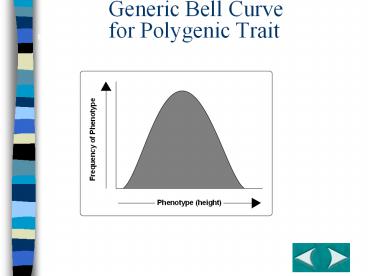Generic Bell Curve for Polygenic Trait - PowerPoint PPT Presentation
1 / 22
Title:
Generic Bell Curve for Polygenic Trait
Description:
Generic Bell Curve for Polygenic Trait Section 16-1 Frequency of Phenotype Phenotype (height) Figure 16 2 Relative Frequencies of Alleles Figure 16 3 Phenotypes ... – PowerPoint PPT presentation
Number of Views:57
Avg rating:3.0/5.0
Title: Generic Bell Curve for Polygenic Trait
1
Generic Bell Curve for Polygenic Trait
Section 16-1
Frequency of Phenotype
Phenotype (height)
2
Figure 162 Relative Frequencies of Alleles
Section 16-1
Sample Population
Frequency of Alleles
allele for brown fur
allele for black fur
48 heterozygous black
16 homozygous black
36 homozygous brown
3
Figure 163 Phenotypes for Single-Gene Trait
Section 16-1
100 80 60 40 20 0
Frequency of Phenotype ()
Widows peak
No widows peak
Phenotype
4
Section Outline
Section 16-2
- 162 Evolution as Genetic Change
- A. Natural Selection on Single-Gene Traits
- B. Natural Selection on Polygenic Traits
- 1. Directional Selection
- 2. Stabilizing Selection
- 3. Disruptive Selection
- C. Genetic Drift
- D. Evolution Versus Genetic Equilibrium
- 1. Random Mating
- 2. Large Population
- 3. No Movement Into or Out of the Population
- 4. No Mutations
- 5. No Natural Selection
5
Genetic Drift
- Random change in allele frequency.
6
Natural Selection on Single Gene Traits
- Natural Selection on single-gene traits can
change allele frequencies leading to evolution. - Ex. Lizards B-Brown b- Red
- What conditions could affect lizard survival?
- soil color- dark soil
- brown blends in survives
- Red easy to see few copies of red allele,
disappear from gene pool
7
Natural Selection on Polygenic Traits
- Natural selection can affect the distribution of
phenotypes - Directional selection- one end of curve favored
evolution favors 1 trait - Ex. Food scarcity-gtgt bigger beaks in birds
- Stabilizing selection-center more fit. Selection
against both extremes. - Ex. Baby birth weight and healthy babies
- Disruptive selection- selection against
intermediate group-gt creates two distinct
phenotypes - Ex. Small and large beaks only.
8
Figure 166 Graph of Directional Selection
Section 16-2
Key
Directional Selection
Low mortality, high fitness
High mortality, low fitness
Food becomes scarce.
9
Figure 167 Graph of Stabilizing Selection
Section 16-2
Stabilizing Selection
Key
Low mortality, high fitness
Selection against both extremes keep curve narrow
and in same place.
High mortality, low fitness
Percentage of Population
Birth Weight
10
Figure 168 Graph of Disruptive Selection
Section 16-2
Disruptive Selection
Largest and smallest seeds become more common.
Key
Population splits into two subgroups specializing
in different seeds.
Low mortality, high fitness
Number of Birdsin Population
Number of Birdsin Population
High mortality, low fitness
Beak Size
Beak Size
11
Genetic Drift
- A random change in allele frequency is called
genetic drift. - Individuals carrying an allele may leave more
descendants-gt allele becomes more common. - Founder effect- migration of small subgroup. Ex.
Hawaiian fruit flies.
12
Genetic Drift
Section 16-2
Sample of Original Population
Descendants
Founding Population A
Founding Population B
13
Genetic Drift
Section 16-2
Sample of Original Population
Descendants
Founding Population A
Founding Population B
14
Genetic Drift
Section 16-2
Sample of Original Population
Descendants
Founding Population A
Founding Population B
15
5 Ways to Maintain Genetic Equilibrium!!!
- Random Mating- equal opportunity to produce
offspring - Large Population genetic drift is less common
in large population - No movement in or out of population cant bring
in new alleles, keep gene pool - No mutations new alleles arise from mutation
- No Natural Selection- No phenotype can have a
selective advantage
16
Hardy-Weinberg Principle
- The frequencies in a population will remain
constant unless one or more factors cause them to
change. - Genetic equilibrium frequencies remain
constant. - 5 ways to maintain genetic equilibrium
17
Hardy-Weinberg Equation
- p22pqq21 (or 100)
- P frequency of dominant allele in gene pool for
a given trait - Q frequency of recessive allele in the gene pool
for a given trait - Gene Frequency of H/ total alleles in genepool
18
Speciation- forming new species
- As species evolve, they become reproductively
isolated from each other.
19
Speciation Isolating Mechanisms
- Reproductive Isolation members of two
populations cannot interbreedwhy? - Behavioral Isolation capable of breeding, but
have different courting rituals or other types of
behavior (coyotes/wolves) - Geographic Isolation separated by geographic
barriers (rivers/mount/etc.) - Temporal Isolation reproduce at different times
(orchids release pollen _at_ diff. times)
20
Speciation in Darwins Finches
- Founders Arrive birds arrive
- Separation of Populations- isolated one bird type
onto 2 island - Changes in Gene Pool through natural selection,
mutation, etc. - Reproductive Isolation new birds dont
cross-breed - Ecological Competition may lead to new bird
- Continued Evolution process continues
21
6 Patterns of MACROEvolution
- Macroevolution- large evolutionary changes that
occur over a long time - Mass extinctions
- Adaptive radiation
- Convergent evolution
- Coevolution
- Punctuated equilibrium
- Changes in developmental genes
22
Reproductive Isolation
Section 16-3
results from
Isolating mechanisms
which include
produced by
produced by
produced by
which result in
Independentlyevolving populations
which result in
Formation ofnew species































